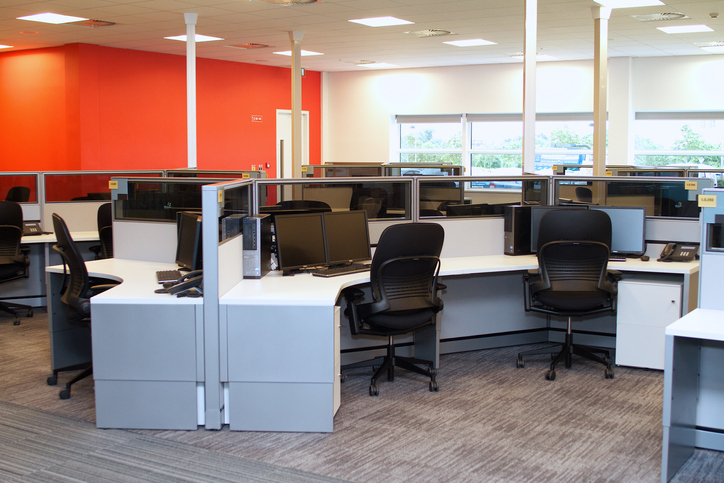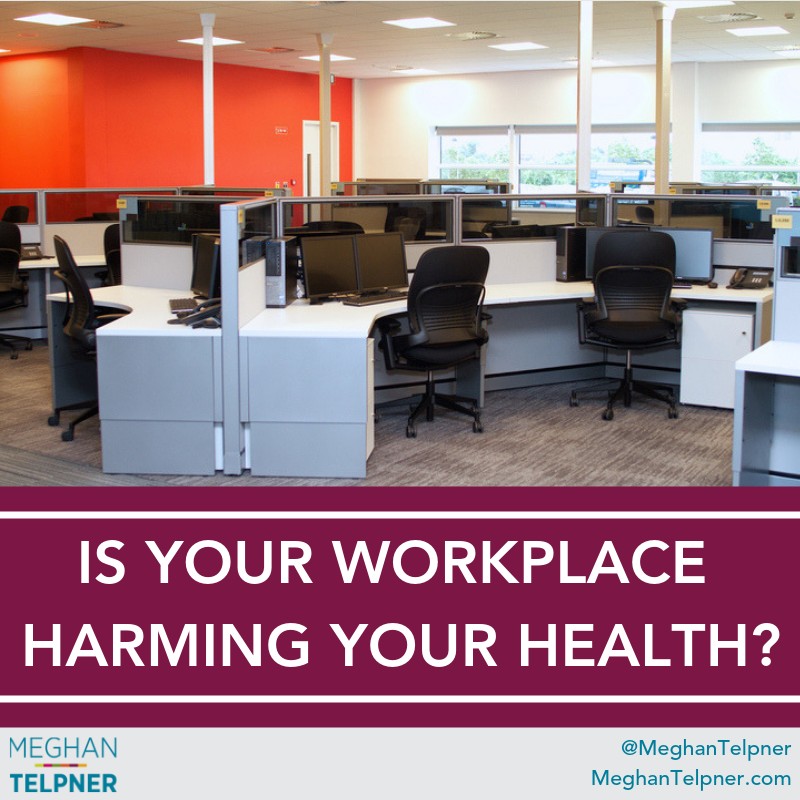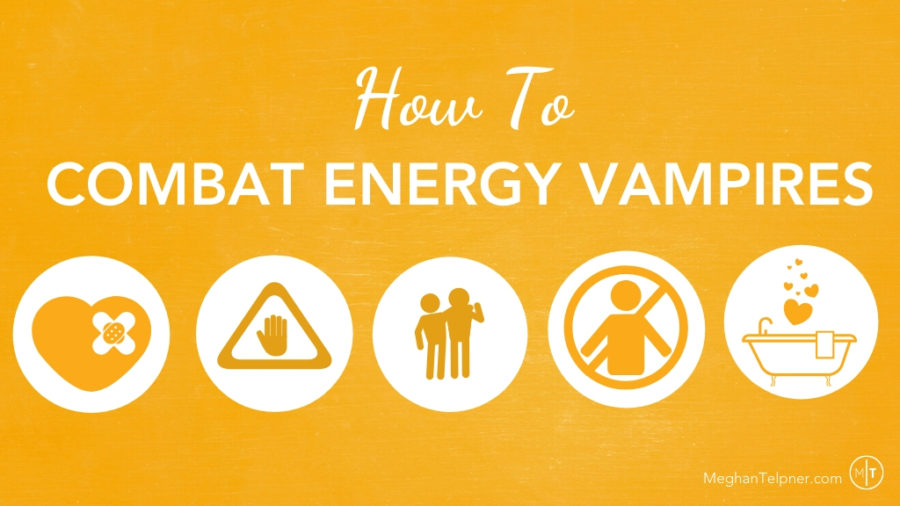Is Your Workplace Harming Your Health?

When I used to interview for jobs I had a very specific (and looking back, an incredibly obnoxious) set of questions I would ask my potential employer regarding workplace health. They included:
- Does the staff have lunch together, or do people eat at their desks?
- Would I be seated near a window?
- Does the window open?
Simple enough, right? But after my first job, where I shared a windowless office in what may or may not have previously been a supply cupboard, I wised up to what mattered to me in a work environment.
We spend about a third of our lives working. If you add in commuting, late nights or weekends and overtime (paid or unpaid, and often now just part of the ‘culture’ at these hot shot operations that serve you all your meals so you never have to leave), some of us end up devoting most of our days to work. In order to focus, be creative, be resourceful, be productive and do our best, we need to feel good while working. Unfortunately, some work environments aren’t conducive to health or productivity. Have you ever considered if your workplace is harming your health?
Having my own business means that I get to control some major things within my workspace. Over the years, my workspace has had many roles – it was once my home, a public space for classes and workshops, it was the birthplace of the Culinary Nutrition Expert Program, and now it is an office (with a fully equipped kitchen for awesome experiments and to cook fresh lunch). I’ve worked hard to cultivate an inviting and healthy workspace for my team that supports everyone’s health. And everyone who works in my office is beside a window that opens!

However, I know that many of you may not be in the same situation at work. There are a number of factors that can detract from your health in the workplace – some of these things you have control of, and others you don’t. Whether you are a business owner, an employee or a manager, it’s important to understand the workplace hazards that influence our health and do what you can to improve it.
12 Common Workplace Health Hazards + What To Do About Them
Fluorescent Lighting
I am incredibly sensitive to light. Fluorescent lighting makes me feel exhausted and those new LEDs going to homes as an energy-efficient solution, reverberate in my brain and give me a headache.
Fluorescent lights, or incandescent bulbs, were once practically the standard in offices around the world. These artificial light sources have since been banned and phased out in many countries for a number of reasons, including eye strain and eye diseases, energy inefficiency, radiation and mercury content. They have been replaced with the compact fluorescent bulb, which is not as harmful but can still impact our circadian rhythm, contribute to headaches, visual effects and neurological symptoms, and may emit radiation at levels that could influence skin cancer. Evidence indicates that some of these bulbs still may emit radiation levels that are outside the considered safe range.
What to Do About Fluorescent Lighting
- Bring in your own desk lamp and shut off fluorescence if/when possible.
- Aim to maximize exposure to natural light on breaks, at lunch and before and after work.
- Try blue blocking glasses while at work to help offset the effects from both fluorescent lighting and computers (more on that below). Companies like Warby Parker now offer a blue blocking lens on their glasses that looks like a regular lens.
Photocopiers and Printers
Photocopiers and printers are essential in many workplaces and certainly, make many work tasks a heck of a lot easier. These machines may be doing more damage to your health than you think for a number of reasons.
- Laser printers emit ultrafine particles (UFPs), teeny compounds that we may inhale, leading to respiratory and cardiovascular health concerns.
- Printers and photocopiers are a source of ozone and can build up inside work environments. Exposure can lead to irritation in your eyes, nose and throat.
- UV radiation, though at very low levels, can be troubling for sensitive eyes and electromagnetic fields (EMFs) can produce a variety of adverse health effects.
- Machines can emit toner dust, which can be linked to inflammation. When the toner hits the paper, this can also produce volatile organic compounds (VOCs) that are harmful to our health. A study of workers who regularly handled toner dust found that those who handled toners for 20 years were more likely to have respiratory symptoms (though the study also concluded that if the toner is well controlled in a safe work environment, the exposure is less likely).
- A study of indoor air in photocopier centers showed that chronic exposure to emissions was linked to high oxidative stress and inflammation.
What to Do About Photocopiers and Printers
- Keep the printer or photocopier away from people in a separate room, if possible (or don’t have them right in people’s cubicles at the very least).
- Keep the area with the printer/photocopier well ventilated.
- Don’t hover over the printer or photocopier while it’s printing or copying.
- Limit printer/photocopier use and send e-documents and materials instead if possible.
- Source sustainable inks and toner cartridges.
- Handle toner cartridges with gloves when installing or removing them.
- Wash hands well after handling printed materials.
Carpeting
Offices and educational institutions typically use carpets to muffle noises and for visual appeal. A large search of scientific literature from 1980 to 2017 concluded that carpeting can be detrimental to our health in a number of ways. Carpeting:
- Emits volatile organic compounds (VOCs) that come from the carpet itself, glues that were used to lay it or the toxic cleaning products used on it. This can irritate those with asthma or allergies, but also cause nose and throat irritation, mild cognitive effects and headaches. VOCs are also linked to cancer.
- Traps pollutants, dust mites, fungi and allergens like pet dander, that can aggravate allergies and asthma.
- Can influence inflammation.
What to Do About Carpeting
- Reduce carpeting if possible
- Look for rugs that are wool or a wool/cotton blend
- Don’t treat carpets with harmful ‘protective’ chemicals like Scotchguard
- Vacuum carpets regularly
- Don’t use chemical carpet cleaners
- Lobby for an ‘inside shoe’ ‘or no-shoe’ policy in the office (I’m pretty sure this is very wishful thinking on my part!)
Air Quality
If you work inside, as a lot of us do, your health is affected by indoor air quality. According to the Environmental Protection Agency, “Americans, on average, spend approximately 90 percent of their time indoors,1 where the concentrations of some pollutants are often 2 to 5 times higher than typical outdoor concentrations.”
Our workplace air quality is affected by cleaning supplies, paints and building materials, carpeting, fragrances, mold, pesticides, appliances, electrical equipment, furniture, dust, allergens and outside pollution blowing inside through open doors or windows. Children, young adults, seniors and those with respiratory conditions or cardiovascular disease are more susceptible to the health risks, which include:
- Eye, nose and throat irritation
- Headaches
- Dizziness
- Fatigue
- Respiratory diseases
- Asthma
- Cardiovascular disease
- Cancer
In an office environment, we’re likely dealing with recycled air or poor ventilation, with no windows that open or no access to windows at all.
What To Do About Office Air Quality
- If you have an office with windows, open them
- Don’t use air fresheners (more on that below)
- Use some air purifying plants
- Bring in charcoal air filters for your workspace or office
- If your workplace has an HVAC system, find out how frequently it gets cleaned (or request regular cleaning).
The EPA has a guide to office building air quality, including what occupants, managers and building owners can do. If you’re not in charge, pass it along to someone who is.
Receipts with BPA/BPS
The thermal paper that receipts are printed on contain bisphenol A (BPA) and Bisphenol S (BPS), which disrupt our hormones and can lead to cancer. Cashiers and retail workers are exposed to BPA and BPS daily when they hand customers receipts. A small experiment conducted by Environmental Defence showed that participants had a spike in BPA and BPS levels in their bodies, which they absorbed through the skin when passing receipts.
A few countries are calling for bans on BPA and BPS in receipts. Some companies are voluntarily using BPA-free receipts that still contain BPS. This was initially thought to be a safer alternative, yet emerging evidence indicates that BPS has the same endocrine-disrupting effects.
If you’re a germaphobe like me you may also be disturbed to learn about the hundreds of microorganisms found on cash, including skin, mouth and vaginal bacteria, viruses and traces of drugs like cocaine.
What to Do About Receipts with BPA and BPS
- Wear gloves when handling receipts or cash
- Wash hands frequently at work, especially before eating or using the bathroom
- Ask customers if they want a printed receipt before printing one
- Source BPA and BPS-free receipt paper
- Write to your local government to request a ban on BPA/BPS in receipts
Air Fresheners
To combat the effects of poor indoor air quality some offices choose to use air fresheners in office spaces, including the bathrooms. The problem with air fresheners is they don’t actually do anything to eliminate the source of the smell, only mask it with gross chemicals that we inhale through our lungs and skin, where they rapidly enter our bloodstream. Some of the common ingredients in air fresheners are:
- Fragrance: This is an umbrella term for a cocktail of chemicals that are linked to allergies, asthma and hormone disruption.
- Formaldehyde: Immediate reactions might include skin irritations, coughing, burning in the eyes, nose and throat, or nausea. Long-term, chronic exposure includes a risk of respiratory lesions, dermatitis and cancer.
- Butylated hydroxytoluene (BHT): This may damage our liver and kidneys, interfere with hormones and promote tumour growth.
- Acetaldehyde: This is connected to allergies, asthma, cancer and skin and respiratory irritation.
What to Do About Fragrance
- Remove all air fresheners and/or scented candles from the office, or ask management to do so
- Open windows if possible
- Clean office spaces thoroughly to remove odors at their source, not just mask them
- If you have a private office space, an essential oil diffuser can be helpful
Perfumes and Scented Personal Care Products
I know we all want to smell good when interacting with colleagues or clients at work. However, the combination of perfumes, scented moisturizers, deodorants, body sprays, scented shampoos and conditioners and more of dozens or hundreds of different people in the office can be dizzying. Your workplace health is being greatly affected by something that could be easily avoidable.
Research by the Environmental Working Group shows that the average woman uses 12 products with 168 chemical ingredients daily, while men use 6 products that contain about 85 ingredients. As a result, one in every 13 women and one in every 23 men are exposed to ingredients that are considered known carcinogens every single day because of their personal care products.
I go into depth about the health effects of perfumes and the ingredients to avoid in personal care products in separate posts, but to sum up these things can be linked to:
- Headaches
- Allergies
- Asthma
- Nausea
- Skin irritation and rashes
- Hormone disruption
- Tumor growth and cancer
- Neurological conditions
- Respiratory issues
What to Do about Fragrance In The Office
- Phase out your conventional beauty care products and switch to natural alternatives, or make your own beauty care products
- The Canadian Centre for Occupational Health and Safety has detailed tips about how to create a scent-free policy in your workplace
Eating Habits
Many work environments challenge our healthy eating goals – there are coffee breaks, vending machines, office parties and meetings. There will always be a reason to celebrate something with a treat and there can be pressure from colleagues to “just have a small piece”. This can send our blood sugar levels out of whack, influence weight gain and lead to inflammation, plus conventional treats or snacks can be loaded with synthetic food dyes, MSG, natural flavour, and other ingredients that are harmful.
What to Do About Creating Healthier Lunch Habits At Work
- Learn how to pack a healthy lunchbox
- If there is a celebration, bring a dessert or snack that is in line with your health goals
- Stock your desk with nutritious snacks so you will have the necessary fuel when energy levels lag
- Have a protein-rich, fat-filled breakfast
- Learn how to say no to food without offending your coworkers
- Check out these tips and recipes to help you eat healthy at work
Staring at Computer Screens
Indoor work environments are usually synonymous with sitting in front of a computer for most of the day. It’s the nature of our digital world and it’s hard to escape from, but it isn’t conducive to workplace health. While there are many benefits to technology, staring at a computer screen all day can cause digital eyestrain (DES). Estimates suggest that at least half of computer users experience some symptoms of DES, which include:
- Dry eyes, burning and irritation
- Headaches
- Blurred vision
- Fatigue
- Eye strain
Staring at a computer can induce soreness and pain in the neck, shoulders or back. The blue light from screens can also be a factor if you are working at all hours of the day, as it prevents us from producing the proper hormones that induce sleep.
What to Do About Screen Time
- Take regular breaks from looking at your computer (set a timer if you need to)
- Place your monitor about two feet away from your head
- Use a large font size so you aren’t struggling to read
- Use eye drops and remember to blink if dry eyes are an issue
- Limit computer and phone use during non-work hours
- Turn off all devices at least an hour before bedtime (but try to stop working well before that!)
- Get yourself some blue blocking glasses to filter out the blue light from screens before it hits your eyeballs. If you wear glasses, some eyewear manufacturers now offer clear ‘blue blocking’ lenses so you can protect your eyes without wearing orange glasses.
Sitting
Computers and long stretches of sitting often go hand in hand. We sit at work, we sit in cars or on transit, and we sit on the couch at home because we’re too tired from our workday to exercise. Some have called sitting the new smoking. Our sedentary lives at work (and home) can lead to health consequences, including:
- Neck, shoulder, back and other muscle pain
- Weight gain
- Hypertension
- Reduced ability to secrete insulin, which may lead to diabetes
- Blood clots
- Thinning of the brain regions responsible for forming memories
What to Do About Sitting For Long Stretches
- Take regular breaks to stretch and walk while at work
- Invest in a standing desk, or make your own
- Walk while you are on the phone, or have walking meetings
- Take the stairs rather than the elevator to your floor
- Walk or bike to work if possible
- Exercise regularly
Workplace Stress
Any type of stress can negatively impact our health, but the workplace can present us with a huge variety of stressors that are hard to deal with: deadlines, challenging tasks, coworker or supervisor conflicts, public speaking or presentations, work travel, shift work, job insecurity, lack of professional development/promotions, job satisfaction, work-life balance, and many more things can cause us stress.
This can lead to depression and anxiety, obesity, diabetes, cardiovascular disease, certain cancers, and substance abuse.
What to Do About Workplace Stress
- Read how I cope with anxiety
- Learn a 30-second coherence technique that is calming, and enhances your ability to be empathetic to others (you can also get instant access to my complimentary coherence class)
- Cultivate good habits for dealing with stress
- Work toward good work-life balance
- Institute a gratitude practice
- Walk in nature
- Consume herbs, foods and nutrients that support the nervous system
There are a lot of moving parts in any office and workplace health must be handled with sensitivity and kindness. It is also something that must be taken seriously, and thankfully many workplaces are recognizing this. When we all collaborate to support workplace health, we’ll end up with happier employees, employers and clients, as well as an amazing work environment where people want to be.

Image: iStock – Lensmen
Free Resource Library
Enjoy more than 40 downloadable guides, recipes, and resources.

























Thank you for this article! In the section that talks about lighting, I wasn’t sure what you are recommending? Seems like all the lightbulbs are bad for us in someway. Will you please clarify?
Thank you for this information, I’ve been handling receipts for over a decade and am extremely worried about the health implications as I’ve just learned about their toxicity.
I’ve tried searching online for appropriate gloves to eliminate contact however I’m not sure what’s best, I’ve seen mention of nitrel gloves but I worry they don’t do enough to prevent contact and make handling receipts or cash safe, do you know what would be the best type of gloves to prevent transmission of BPA & harmful bacteria from cash? Are they any reusable options or are disposable options the only way to go?
Insight is much appreciated